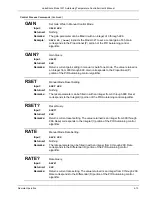
Lake Shore Model 321 Autotuning Temperature Controller User’s Manual
Remote Operation
4-3
Message Strings (Continued)
A command string is issued by the computer and instructs the instrument to perform a function or
change a parameter setting. The format is <command mnemonic><space><parameter
data><terminators>. Command mnemonics are listed in Paragraph 4.2. Parameter data necessary for
each one is described in Paragraph 4.2.1. Terminators must be sent with every message string.
A query string is issued by the computer and instructs the instrument to send a response. The query
format is <query mnemonic><?><space><parameter data><terminators>. Query mnemonics are
often the same as commands with the addition of a question mark. Parameter data is often
unnecessary when sending queries. Query mnemonics are listed in Paragraph 4.2. Parameter data if
necessary is described in Paragraph 4.2.1. Terminators must be sent with every message string. The
computer should expect a response very soon after a query is sent.
A response string is the instruments response or answer to a query string. The instrument will
respond only to the last query it receives. The response can be a reading value, status report or the
present value of a parameter. Response data formats are listed along with the associated queries in
Paragraph 4.2.1. The response is sent as soon as possible after the instrument receives the query.
Typically it takes 10 ms for the instrument to begin the response. Some responses take longer.
4.1.5 Message
Flow
Control
It is important to remember that the user program is in charge of the serial communication at all times.
The instrument can not initiate communication, determine which device should be transmitting at a
given time or guarantee timing between messages. All of this is the responsibility of the user program.
When issuing commands only the user program should:
•
Properly format and transmit the command including terminators as one string.
•
Guarantee that no other communication is started for 50 ms after the last character is transmitted.
•
Not initiate communication more than 20 times per second.
When issuing queries or queries and commands together the user program should:
•
Properly format and transmit the query including terminators as one string.
•
Prepare to receive a response immediately.
•
Receive the entire response from the instrument including the terminators.
•
Guarantee that no other communication is started during the response or for 50 ms after it
completes.
•
Not initiate communication more than 20 times per second.
Failure to follow these simple rules will result in inability to establish communication with the
instrument or intermittent failures in communication.
4.1.6 Changing Baud Rate
To use the Serial Interface, you must first set the Baud rate. Press
Interface
key to display the
following screen.
Press the
s
or
t
keys to cycle through the choices of 300 or 1200 Baud. The rate selected will have
a right pointing arrow (
Æ
) immediately to the left. Press
Enter
to accept the new number.






























